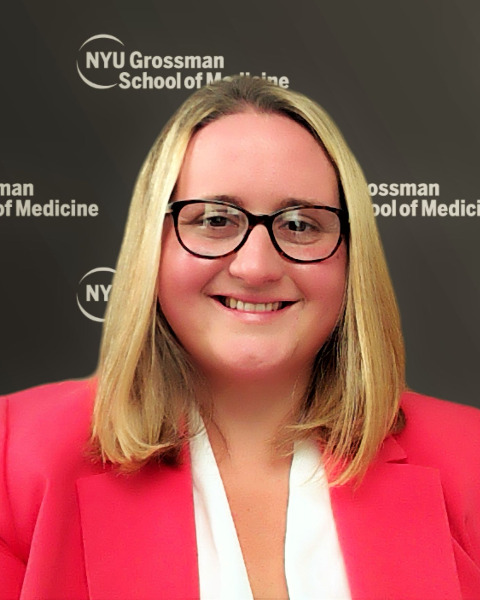Anatomy Education: Teaching Methods & Innovations Posters
Poster: Anatomy Education: Teaching Methods & Innovations Posters
95 - Acute or Chronic: Best Prognosis for Anatomy Instruction in an Accelerated Curriculum
Saturday, March 23, 2024
5:00pm - 7:00pm US EDT
Location: Sheraton Hall
Poster Board Number: 95
There are separate poster presentation times for odd and even posters.
Odd poster #s – first hour
Even poster #s – second hour
Co-authors:
There are separate poster presentation times for odd and even posters.
Odd poster #s – first hour
Even poster #s – second hour
Co-authors:
Victoria Harnik - NYU Grossman School of Medicine; Mel Rosenfeld - NYU Grossman School of Medicine; Sally Frenkel - NYU Grossman School of Medicine; Michael Poles - NYU Grossman School of Medicine

Kristen Ramirez, MPhil
Research Instructor
NYU Grossman School of Medicine
New York, New York, United States
Presenting Author(s)
Abstract Body : Emerging trends in pre-clerkship medical education include acceleration of the basic sciences and greater integration with the clinical sciences. In the first 2 years of an accelerated 11-month pre-clerkship curriculum at NYU Grossman School of Medicine, anatomy content was distributed in two different ways. During academic year (AY) 2022-2023 anatomy was regionally separated and integrated into the 3 organ system modules. Thorax and renal system were taught at the beginning of the cardio-pulmonary-kidney module, GI and pelvis were taught separately within the GI-endocrine-reproduction module, and extremities, head and neck were taught at the beginning of the brain and behavior module. The following year (AY 2023-2024), thorax, abdomen, and head and neck were combined as one independent module preceding the organ systems. Pelvis and extremities would still be taught adjacent to their respective content areas in subsequent modules. Here, we compare anatomy exam performance and student evaluations between the two MS1 cohorts.
For all topics except the renal system, students performed better in AY 2023-2024 when content was delivered together compared to the prior longitudinally integrated year. Among exam questions that were the same between the two years, the percentage of students correctly answering the questions increased on average by 11%. However, there was no statistically significant difference between the two cohorts, likely due to the small number of questions per topic. The most dramatic change in exam scores was the low marks for thorax and innervation taught during AY 2022-2023 (63%) compared to all other topics from both years (mean = 83%, SD = 3%). We hypothesize this is due to the intersection of novice anatomy learners having the least amount of time to consolidate information prior to their first anatomy exam.
While student exam performance improved in AY 2023-2024, satisfaction with the anatomy material’s deployment was higher in AY 2022-2023. Students preferred anatomy integrated within the organ systems, and asked for more integration throughout the 3 organ systems modules in AY 2022-2023. Across both years the most frequent feedback was to increase anatomy instructional time, emphasizing less compressed lectures, more lab exposure to specimens, and more time between learning and examination.
While student desire for more time conflicts with the aims of an accelerated curriculum, strategies to build upon a superficial anatomical foundation with more clinically-relevant details in later modules should be explored. Pedagogical innovations require iterative experimentation to identify best practices. More experimentation and discourse are required to align the dual interests of increasing student performance and satisfaction in the new curriculum.
For all topics except the renal system, students performed better in AY 2023-2024 when content was delivered together compared to the prior longitudinally integrated year. Among exam questions that were the same between the two years, the percentage of students correctly answering the questions increased on average by 11%. However, there was no statistically significant difference between the two cohorts, likely due to the small number of questions per topic. The most dramatic change in exam scores was the low marks for thorax and innervation taught during AY 2022-2023 (63%) compared to all other topics from both years (mean = 83%, SD = 3%). We hypothesize this is due to the intersection of novice anatomy learners having the least amount of time to consolidate information prior to their first anatomy exam.
While student exam performance improved in AY 2023-2024, satisfaction with the anatomy material’s deployment was higher in AY 2022-2023. Students preferred anatomy integrated within the organ systems, and asked for more integration throughout the 3 organ systems modules in AY 2022-2023. Across both years the most frequent feedback was to increase anatomy instructional time, emphasizing less compressed lectures, more lab exposure to specimens, and more time between learning and examination.
While student desire for more time conflicts with the aims of an accelerated curriculum, strategies to build upon a superficial anatomical foundation with more clinically-relevant details in later modules should be explored. Pedagogical innovations require iterative experimentation to identify best practices. More experimentation and discourse are required to align the dual interests of increasing student performance and satisfaction in the new curriculum.

